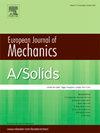各向异性三角形晶格中的断裂韧性和裂纹扩展
IF 4.2
2区 工程技术
Q1 MECHANICS
引用次数: 0
摘要
研究了各向异性三角形晶格的断裂韧性、临界能量释放率和裂纹扩展阻力(r曲线)。各向异性是通过改变支柱的厚度比t´来调整晶格微观结构,同时保持恒定的相对密度。采用基于边界层技术的有限元方法对I型断裂响应进行了分析。模拟结果表明,断裂韧性与t′具有非单调依赖性,峰值出现在不同的厚度比下,这取决于相对于晶格拓扑的裂纹取向。相应的临界能量释放率也表现出相同的非单调趋势,但对t有明显的依赖性。裂纹扩展分析表明,各向异性对裂纹扩展阻力和相应的裂纹扩展路径都有强烈的影响。其中,当初始裂纹线与竖向支板垂直时,增大t′′会增强阻力,裂纹有沿初始裂纹线扩展的趋势。另一方面,当初始裂纹线与垂直支板平行时,增大t′首先导致断裂韧性和裂纹扩展阻力降低,并伴随着沿初始裂纹线由斜向扩展过渡。然而,超过临界厚度比(t >≈1.50),穿透扩展仅持续到距离初始裂纹尖端有限的距离,之后裂纹沿倾斜路径恢复扩展。裂纹扩展过程的这种变化显著增强了裂纹扩展阻力。总之,这些结果为各向异性晶格的断裂响应提供了关键的见解,为设计具有提高韧性和控制裂纹扩展的建筑材料提供了实用指导。本文章由计算机程序翻译,如有差异,请以英文原文为准。
Fracture toughness and crack propagation in anisotropic triangular lattices
This study investigates the fracture toughness, critical energy release rate, and crack growth resistance (R-curve) of anisotropic triangular lattices. Anisotropy is introduced by tailoring the lattice microstructure through variations in the thickness ratio of struts, while maintaining a constant relative density. The mode I fracture response is analyzed using the finite element method, based on a boundary layer technique. The simulations demonstrate a non-monotonic dependence of the fracture toughness on , with peak values occurring at distinct thickness ratios depending on the crack orientation relative to the lattice topology. The corresponding critical energy release rate exhibits the same non-monotonic trend, but with a distinct dependence on . The crack propagation analysis reveals that anisotropy strongly affects both the crack growth resistance and the corresponding crack growth path. Specifically, when the initial crack line is perpendicular to the vertical struts, increasing enhances resistance, and the crack tends to propagate along the initial crack line. On the other hand, when the initial crack line is parallel to the vertical struts, increasing first leads to a reduction in both fracture toughness and crack growth resistance, accompanied by a transition from slanted propagation to penetration along the initial crack line. However, beyond a critical thickness ratio (), the penetration growth persists only up to a limited distance from the initial crack tip, after which crack propagation resumes along a slanted path. This variation in the crack propagation process significantly enhances the crack growth resistance. Altogether, the results provide key insights into the fracture response of anisotropic lattices, offering practical guidelines for designing architected materials with improved toughness and controlled crack propagation.
求助全文
通过发布文献求助,成功后即可免费获取论文全文。
去求助
来源期刊
CiteScore
7.00
自引率
7.30%
发文量
275
审稿时长
48 days
期刊介绍:
The European Journal of Mechanics endash; A/Solids continues to publish articles in English in all areas of Solid Mechanics from the physical and mathematical basis to materials engineering, technological applications and methods of modern computational mechanics, both pure and applied research.

 求助内容:
求助内容: 应助结果提醒方式:
应助结果提醒方式:


